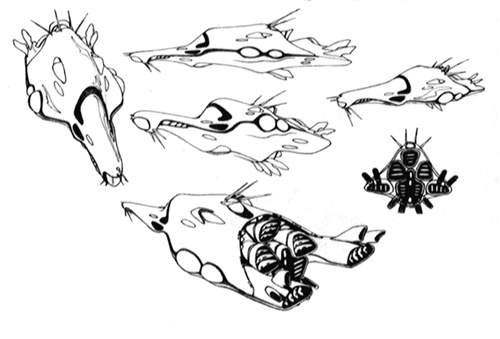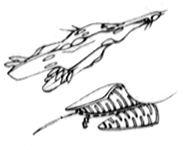

Designation:Queadol Magdomilla-Whouva class Amphibious Command Ship |
|
||||

|
|||||
Note: While Zentraedi ships have been assigned Terran naval/space type designators, it must be stressed that their size and armaments placed them in a class of their own, matched only by contemporary Tirolian and modern Terran construction of like designations. As such, their designations must be viewed as indicators of intent and use rather than absolute strength. In addition, the proper translation of the Zentraedi vessel designations into English was never completely agreed upon; for instance, some texts call the Queadol Frandnitsz-class amphibious command ship a 'landing control vessel' or 'assault leader vessel'.
These ships were built at numerous locations throughout the Robotech Mercantile Empire from 1268 through 1809 and on board the Zentraedi Factory Satellite from 1807 through 2009. There have been at least eight consecutive versions, with the first version having a very small production runs (243) and surviving units upgraded to the newer versions as they came in for refits. The total number of constructed vessels is 96,178.
Of this number, approximately 17,300 were destroyed or scrapped due to advanced age prior to 2010. The Ci'Vonian defection (1519) included 4,119 Queadol Magdomilla-Whouva command ships (all connected to Queadol Magdomilla-Luhoutzs hulls) of which approximately 3,890 were confirmed as destroyed (this number includes units with action damaged assessed to be so heavy to become probable constructional total losses) during subsequent offensives and skirmishes. The fate of the remaining vessels is unknown. The Imperial Fleet contained 25,110 Queadol Magdomilla-Whouva-class vessels (with attendant Queadol Magdomilla-Luhoutzs hulls) all sharing in the "infection" of that fleet. Of the remaining Tirolian controlled ships approximately 43,650 were part of the Grand Fleet. After the Zentraedi Holocaust, an estimated 6,000 Queadol Magdomilla-Whouva-class ships remained intact or salvageable. Most of these failed or were decommissioned due to protoculture depletion prior to 2020.
(Note: only the types carried by the last version are mentioned. All older versions of the Queadol Magdomilla-Whouva were refitted with these systems).

The Queadol Magdomilla-Whouva was better known as the nose section of the Queadol Magdomilla task force command ship. Given that the two sections nearly always operated together however, the Magdomilla name was used in common speech for the combined ship, as it will be in these writings where appropriate.
Externally, the Quaedol Magdomilla-Whouva is one of the most 'bumpy' Zentraedi ships, with a very elongated nose an a huge bulging superstructure towards the rear. The aft end is composed almost entirely out of engine clusters, with three fusion-plasma engines for space flight and numerous secondary plasma-shock engines for additional atmospheric thrust. Several secondary engines are mounted in streamlined clusters on top of the other engines; these give the ship the appearance of having fins. A mecha release hatch is located in the bottom. Four sensor aerials are mounted on top and a another cluster is under the nose. The forward hull of the class is more heavily armoured than other Zentraedi ships as one of the designed missions was 'hot landing zone insertion', in which the ships could expect to encounter voluminous enemy fire.
Internally, there are seven deck levels. The command spaces and crew quarters are mounted in the 'hump', the service and mecha hangarage in the hull proper. The forward spike houses turret machinery and the high-resolution sensor arrays of the Queadol Magdomilla-Luhoutzs. All mecha launch through the same hatch, in the bottom. While this is not desirable when action damage to the hangar is considered, the installation does allow for a concentrated combat drop by the infantry. The Gnerl fighters also launch through this hatch from the Magdomilla-Whouva. When the Magdomilla-Whouva and the Magdomilla-Luhoutzs are coupled, combat launches by Magdomilla-Whouva mecha are often made from the Magdomilla-Luhoutzs section.
The armament of the Magdomilla-Whouva was at the same time heavy and underpowered. The heavy guns of the Queadol combination, four heavy anti-ship cannons, are mounted directly behind the prow, but the small size of the ship and hence of the generators severely limits the available power capacity and thus the rate of fire. The Magdomilla-Whouva has between 20% and 25% the normal rate of fire for these weapons, if the ships are disconnected. When connected, the generators of the Queadol Magdomilla-Luhoutzs will add their power to that generated by the Magdomilla-Whouva and allow a normal firing rate. Although the vessel does mount the standard Zentraedi medium cannons and defensive missiles, there are no heavy torpedo tubes, as these are all mounted on the Queadol Magdomilla-Luhoutzs.
In 1265 the Queadol Magdomilla concept was devised as an efficient means of building a task force command and amphibious assault command ship in one. The solution to built two ships, one with the means to carry out assault landings and command duties and one to haul the large engines, mecha complement, fold drive and other equipment that were not required for the assault task, was at first considered a high risk, but as the first series of ships proved itself in service, the critics were silenced, and massive production efforts began.
Due to the position on the bow of combat vessels, and its assault taskings during landings, the Magdomilla-Whouva class suffered heavier losses than its larger sister, the Magdomilla-Luhoutzs. Therefore, production of the former outstripped that of the later. The Magdomilla-Whouva was very effective as a landing command and/or assault vessel, and was therefore one of the first classes to be refitted with the modern Quaedluun-Rau power armours. In combat, the Magdomilla-Whouva often air-dropped its infantry right after the initial bombardment, using its heavy construction and defensive armament to smash through any remaining defenses. With an initial landing zone secured, the more vulnerable Zentraedi ships and auxiliaries could begin ferrying troops and supplies. This gave the Zentraedi forces a credible 'hot-zone' insertion tactic; the vulnerability of the other craft limited them mostly to dropship-delivered troops at a point a safe distance from the defended target. However, care still had to be taken that the Magdomilla-Whouva was not employed against an enemy position without orbital softening up first, or worse, alone against another ship. The armament might have been impressive on paper, but in reality the Magdomilla-Whouva was a sitting duck, slow and lacking a solid punch against these targets. It took the Magdomilla-Luhoutzs section to achieve an acceptable (even favourable) vessel against such threats.
As with the majority of the Zentraedi, this class was mostly destroyed in the Solar System during and after the Zentraedi Holocaust. Although numerous Queadol Magdomilla-Luhoutzs ships survived the fighting, the three survivors that didn't leave the system with non-assimilated Zentraedi were among the first vessels drained of whatever protoculture remained and placed in reserve. This was because there was relatively little demand for their specialized taskings in the RDF Zentraedi fleet, as these were stationed in the Solar System exclusively, with the inhabited planet in friendly hands. The ships outside the Solar System soon met the fate of their other brethren and lost generator power at such a rate that almost none remained after 2022. Those three vessels that were mothballed and stored in the Sol System are effective total losses after the Invid scavenged and wrecked them.
Return to Zentraedi Index
Go to Robotech Reference Guide Home Page.
Robotech (R) is the property of Harmony Gold. This document is in no way intended to infringe upon their rights.
Content by Pieter Thomassen and Peter Walker
Copyright © 2004, 1998 Robert Morgenstern, Peter
Walker, Pieter Thomassen